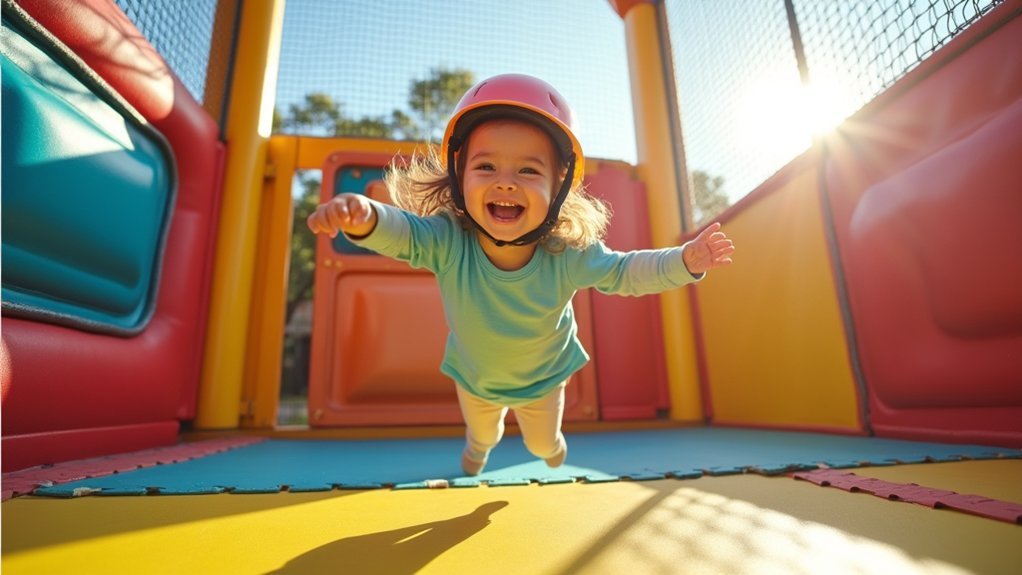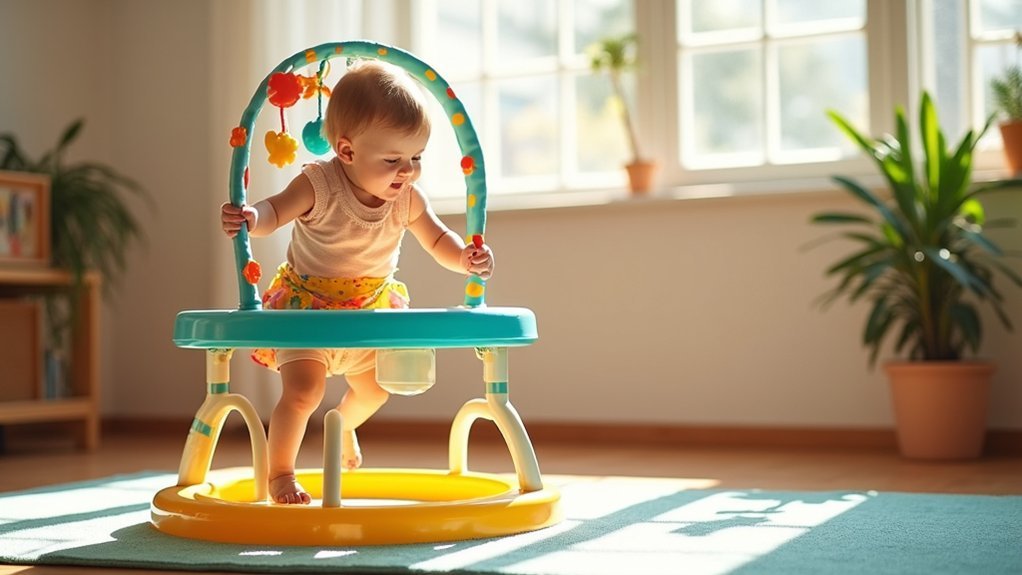When selecting a mini-jumper for your child, prioritize these seven critical safety features: full-coverage padding over all springs and frames, sturdy enclosure nets with secure entry systems, age-appropriate height and design, weather-resistant materials, verified weight capacity, stability elements like handlebars, and non-slip surfaces. Don’t compromise on ASTM F381 certification and proper installation procedures. These essentials form your defense against the most common trampoline injuries children experience during playtime.
7 Safety Features Every Child’s Mini-Jumper Needs

When shopping for a child’s mini-jumper, safety should always be your top priority. Look for models with a robust frame that meets ASTM F381 standards for weight-bearing capacity and impact resistance.
Ensure the jumper has appropriate enclosure features—at least 5-foot high netting with tight mesh and zippered, self-closing entry points. The netting should connect securely to the frame with no gaps at the bottom edge.
Safety first: Choose mini-jumpers with 5-foot high netting, tight mesh, and secure, self-closing entries with no gaps.
Check for stability features like wide-stance legs with slip-resistant bases and proper anchoring. All edges should be rounded per federal safety regulations, and there should be no pinch points in folding mechanisms. Verify that the trampoline includes complete padding coverage over all springs and frame components to prevent pinching injuries.
Don’t overlook clear weight limit warnings and UV-resistant materials for outdoor durability. Third-party certification offers additional peace of mind that the mini-jumper meets rigorous safety standards.
Full-Coverage Padding: The First Line of Defense
Your child’s safety is compromised when mini-jumper padding becomes torn, creating dangerous catch points for small fingers and toes.
You’ll need to regularly inspect the padding for rips, tears, or deterioration that could expose the springs or frame.
Complete edge-to-spring protection is essential, as even small gaps between the jumping surface and frame padding can lead to serious pinching injuries.
Studies show that injuries related to frame and springs make up just over 19% of all trampoline-related injuries, highlighting the importance of proper padding maintenance.
Torn Padding Dangers
Three vital dangers emerge when a mini-jumper’s padding becomes torn or damaged.
First, gaps expose your child to metal frames and springs, creating immediate injury risks. These exposed components can cause cuts, bruises, and more severe injuries if your child lands on them during play.
Second, torn padding compromises the entire safety system of your mini-jumper. What starts as a small tear can quickly worsen with continued use, extending the dangerous area.
Third, damaged padding often shifts position, leaving essential areas completely unprotected. This is especially concerning given that fractures and sprains account for over 67% of all trampoline-related injuries in children.
You’ll need to inspect padding regularly for signs of wear and tear.
Replace any damaged sections immediately—never let your child use a mini-jumper with compromised padding.
Edge-to-Spring Protection Essential
Full-coverage padding serves as the critical barrier between your child and the mini-jumper’s mechanical components.
You’ll want to guarantee the pad extends edge-to-edge, completely covering all springs and hardware with overlapping seams that eliminate dangerous gaps.
Look for contoured edges that won’t lift during active bouncing and a minimum 1-inch thickness across all surfaces for proper impact dispersion.
The underside should feature non-slip materials to prevent shifting during use.
Quality padding incorporates high-density closed-cell foam that won’t deform under pressure, maintaining its protective properties even after repeated jumps.
The Mini Bumper Pads are specifically designed to cover exposed bolts on the top octagon of the Jungle Jumparoo, enhancing safety during active play.
The design should fully encapsulate spring channels with rounded corners to reduce tripping hazards.
Sturdy Enclosure Nets: Preventing Falls and Tumbles

When selecting a mini-jumper for your child, you’ll want to check that it uses high-density mesh that can withstand impact while maintaining visibility.
Look for secure entry systems with overlapping doors or fail-safe zippers that won’t accidentally open during play. Many premium safety nets feature patented Triple-fail-safe designs that provide multiple layers of protection for maximum security.
Proper installation of the enclosure net is essential—ensure all components connect firmly and that flexible rods or poles are correctly positioned to provide 360° protection.
Mesh Quality Matters
The integrity of your child’s mini-jumper enclosure net directly impacts their safety during play. Look for nets made of heavy-duty polyethylene or TenCate Permatron with UV stabilization to prevent sun damage and guarantee lasting tear resistance.
ASTM certification standards require nets to undergo rigorous durability and impact-resistance testing. Quality nets feature reinforced stitching at stress points like corners and door seams, plus rust-proof hardware that won’t deteriorate outdoors. Falling off trampolines accounts for 27%-39% of all trampoline injuries, highlighting why proper enclosure nets are essential.
The best designs maintain vertical orientation to guide falls toward the rebound surface while preventing gaps around the perimeter. You’ll want a system that maintains consistent tension and avoids creating finger or toe traps in the mesh.
Secure Entry Systems
Safety systems that provide secure entry and exit points represent a critical component of mini-jumper design.
Your child’s mini-jumper needs a sturdy enclosure net that meets ASTM F225 standards for durability and impact resistance. These nets greatly reduce injuries by preventing falls while jumping.
Make certain the net is tall enough to prevent jumpers from clearing it and has secure connections at the bottom to avoid breakage.
Look for UV-resistant materials that won’t deteriorate quickly in sunlight. The net’s straps should maintain their integrity over time—many recalls have resulted from strap failures.
Remember that nets are designed for fall prevention, not for hanging or bouncing against. Following the one jumper rule is essential to maintain the safety integrity of the enclosure system and prevent collision injuries.
Even with secure entry systems, always supervise children and follow age recommendations to guarantee your mini-jumper remains a safe play environment.
Proper Net Installation
Proper installation of your mini-jumper’s enclosure net forms the foundation of your child’s safety system.
Begin by inserting enclosure poles into the lower rails, ensuring they’re secure. Connect these to vertical poles using the plastic connectors provided.
When attaching the safety net, look for green tags or other markers to align it correctly with the frame. Secure the bottom of the net to the jump mat’s triangle rings using the plastic hooks. The net should be taut with no sagging areas where children could fall through.
When securing the bottom of the net around the trampoline, implement the Type B Installation method for optimal safety and stability.
Check that there’s no gap between the net and frame—this prevents limbs from slipping through.
Regularly inspect your installation for loose attachments, wear, or damage.
Age-Appropriate Height and Design Considerations

When selecting a mini-jumper for your child, age-appropriate height and design considerations should be your top priority. For children under 6, choose low-profile frames that minimize fall distances and follow AAP guidelines for minimum age restrictions.
Look for models with non-slip jumping surfaces and padded handles that support developing balance. The mini-jumper’s dimensions should be proportional to your child’s height and weight to prevent unstable bouncing.
Choose designs with adjustable resistance settings that accommodate your child’s motor skill development. Soft-edged jumping zones and removable safety rails can be invaluable as your child’s coordination improves.
For children with special sensory needs, consider models with limited bouncing ranges. Adult supervision is essential during use to prevent serious injuries that commonly occur with jumping equipment.
Remember that manufacturer-specified weight limits aren’t suggestions—they’re safety requirements designed to match your child’s developmental stage.
Weather-Resistant Materials for Long-Term Safety
Beyond age-appropriate design, the materials used in your child’s mini-jumper directly impact both safety and longevity.
Look for products with high waterproof ratings (10,000 WP+) and seam-sealed construction to prevent moisture damage that could compromise structural integrity.
Quality mini-jumpers feature recycled nylon ripstop or reinforced PVC blends with woven nylon thread cores that resist tearing even with daily use.
The best options include breathable waterproof fabrics with moisture-wicking liners to prevent slippery surfaces from sweat buildup.
Prioritize OEKO-TEX® or bluesign® certified materials that guarantee your child isn’t exposed to harmful chemicals. Companies like Miniature.com prioritize outerwear that is OEKO-TEX® certified to ensure products are free from harmful chemicals that could cause skin irritation.
UV-resistant treatments prevent degradation from sunlight exposure, while machine-washable coatings maintain waterproofing through 50+ washes.
These features guarantee your mini-jumper remains safe regardless of weather conditions.
Weight Capacity and Structural Integrity Standards
Understanding your mini-jumper’s weight capacity and structural integrity standards is critical for your child’s safety. Mini trampolines designed for toddlers typically support 50-100 lbs, while exercise rebounders can handle up to 600 lbs.
Always adhere to manufacturer guidelines about multiple jumpers—most mini trampolines are limited to one user at a time.
Look for high-quality steel frames, reinforced jumping surfaces, and strong seam construction. These features guarantee the mini-jumper can withstand repeated use without compromising safety. Exceeding the weight limit can cause bottoming out and potentially lead to injuries.
Premium models often feature spring-free designs that eliminate pinch points.
Check for compliance with ASTM F381 testing standards and CE certification, which indicate the product has undergone rigorous safety testing.
Remember that a longer warranty often signals more robust construction that will maintain its integrity throughout your child’s developmental stages.
Stability Features: Handlebars and Non-Slip Surfaces
Stability emerges as the next critical safety component in any child’s mini-jumper. When selecting a model, look for padded handlebars with height-appropriate design that guarantees proper posture for your child’s size. Our recommended mini-jumper includes a sturdy handlebar for additional stability during use. The T-weld leg construction paired with these handlebars greatly enhances frame rigidity during active jumping sessions.
Non-slip surfaces provide equally important protection. UV-resistant jump mats featuring printed center targets improve your child’s spatial awareness while reducing slip accidents. The textured grip zones prevent hands and feet from sliding during vigorous movement.
For complete stability, check that the mini-jumper includes rubberized foot caps on the legs and weatherproof surfaces that maintain traction even in damp conditions. Wide-leg positioning with a low center of gravity will prevent tipping while accommodating your child’s most enthusiastic bounces.
Frequently Asked Questions
How Do I Clean and Sanitize My Child’s Mini-Jumper?
You’ll need to clean the seat with mild soap, wiping it with a damp cloth. Sanitize the frame using a mild disinfectant, and make sure everything dries completely. Perform weekly dusting and monthly deep cleanings.
Can Mini-Jumpers Be Used for Physical Therapy or Developmental Benefits?
Yes, mini-jumpers provide excellent physical therapy benefits! You’ll see improvements in your child’s balance, coordination, and muscle tone while they bounce. They’re particularly helpful for developing proprioception and motor skills through enjoyable movement experiences.
What’s the Ideal Age to Transition From Mini-Jumpers to Full-Sized Trampolines?
You shouldn’t shift your child to a full-sized trampoline until they’re at least 6 years old, have good coordination, understand safety rules, and demonstrate mature decision-making. Always consult your pediatrician for personalized guidance.
Are Indoor Mini-Jumpers Safer Than Outdoor Models?
Indoor mini-jumpers are generally safer with their lower bounce heights, reduced fall distances, and protection from weather hazards. However, you’ll still need proper supervision and safety features regardless of which type you choose.
How Often Should Professional Safety Inspections Be Conducted?
You should schedule professional safety inspections for mini-jumpers quarterly. For heavily used equipment, consider monthly checks. Don’t forget to perform your own visual inspections daily before each use to guarantee safety.
In Summary
Don’t compromise on your child’s safety when choosing a mini-jumper. You’ll sleep better knowing you’ve selected a model with thorough padding, reliable nets, and appropriate size for their age. Remember to check the weight limits, stability features, and weather resistance before purchasing. By prioritizing these seven safety features, you’re investing in both fun and protection for your little one’s bouncing adventures.





Leave a Reply